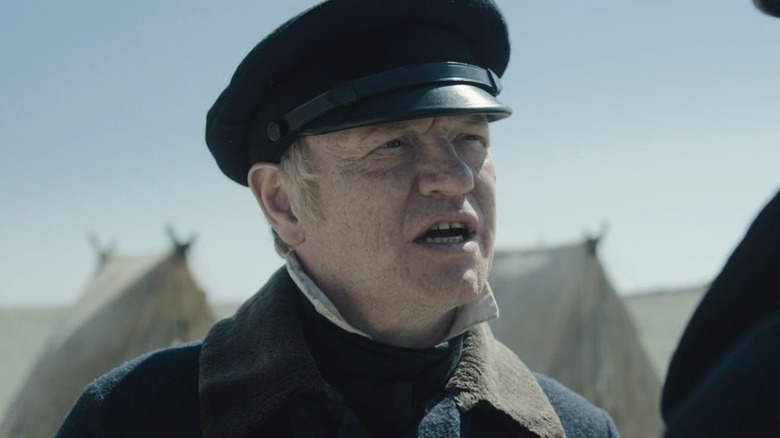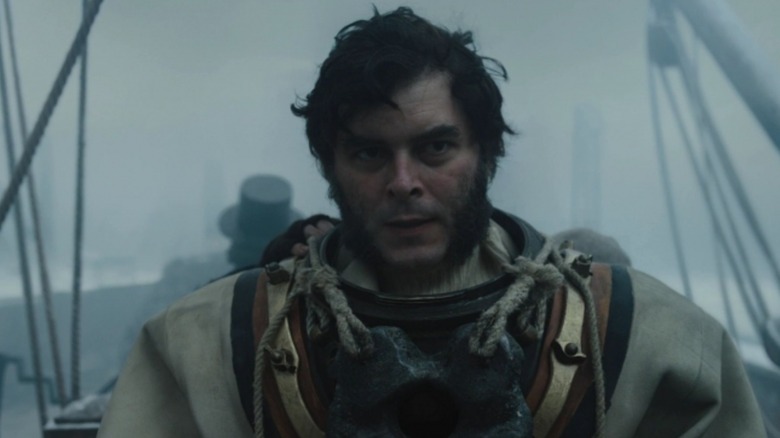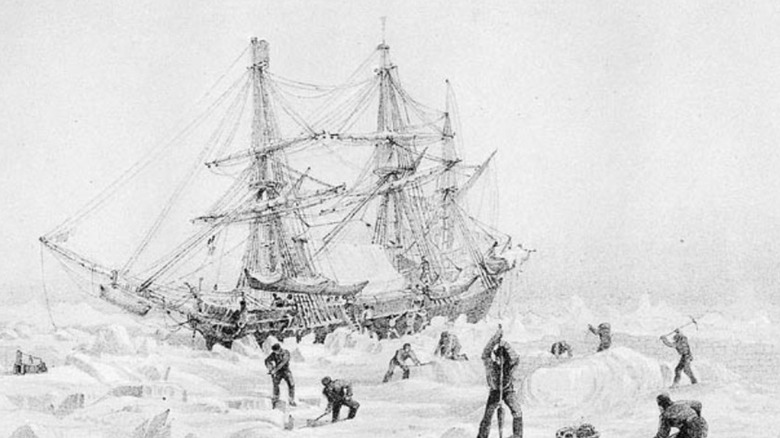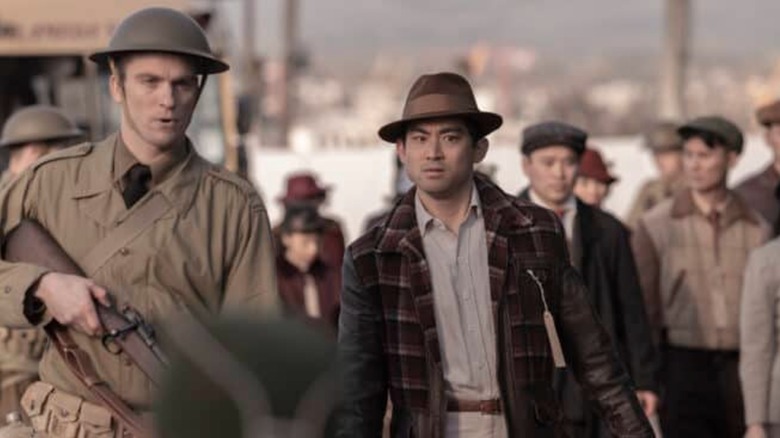Is The Terror Based On A True Story?
Set in the mid-19th century, AMC's hidden gem horror series "The Terror" is a bone-chillingly bleak fictional recreation of a doomed real-life Arctic expedition. The HMS Terror and HMS Erebus set out to find the long-sought Northwest Passage, a shortcut between the Atlantic and Pacific Oceans that sailors had been predicting could revolutionize trade for hundreds of years. Combining a historical horror story with supernatural elements, Season 1 of "The Terror" recounts the British ships' journey through the Canadian Arctic as they become trapped in ice, with the crew finding themselves tormented by terrors both seen and unseen as they struggle to survive in unsurvivable circumstances.
Aided by outstanding performances from actors Ciarán Hinds, Tobias Menzies, and "Foundation" star Jared Harris, the series paints a desolate picture of dread and misery in what must have felt like an alien world to the real-life crews. While it's unlikely the real expedition was stalked by a bloodthirsty Inuit spirit-bear called a Tuunbaq — the cryptid that plagues the crew of "The Terror" — this creature is arguably not the most frightening aspect of the story. From botulism to full-blown cannabalism, the real tale that inspired the series is even scarier than AMC's ice-encrusted nightmare.
What happened in The Terror Season 1
"The Terror" Season 1 opens with British naval officer John Ross (Clive Russell) investigating the fate of the Terror/Erebus expedition, before flashing back to the journey years prior. Things go off the rails fairly quickly when a sailor unexpectedly dies of a hemmorhagic condition and the Erebus comes to a halt after breaking its propeller on the ice. Although the expedition's second-in-command, Francis Crozier (Jared Harris), has voiced his doubts about the ships' ability to make it through the archipelago before the ice begins to thicken, Captain John Franklin (Ciarán Hinds) pushes them onward anyway. Before long, both ships are effectively stuck in pack ice, forcing them to spend the winter there.
Conditions effectively deteriorate from there. Parties sent on foot the following June in search of open water come up empty. Meanwhile, immediately after accidentally shooting an Inuit shaman traveling with his daughter, the other party is violently attacked by the Tunnbaq, which looks a bit like a mutant polar bear with a human-like visage. After the man's death, the creature continues to pick off the crew members one by one, fostering severe paranoia in their already rapidly declining conditions as nearly two years pass with the ships hopelessly embedded in the ice.
Things only get worse from there: there's Crozier's severe alcohol withdrawal, gangrene, a limited amount of canned food that's tainted with botulism and lead poisoning, war with the local natives, and wholesale massacre and cannibalism among the crew. At the end, only Crozier is left alive, having adopted the Inuit ways and joined the shaman's daughter.
The real story of the Terror and the Erebus
Perhaps the scariest thing about "The Terror" Season 1 is that aside from the series' supernatural elements, a lot of it is rooted in what we know of the real Erebus and Terror. At the time of the expeditions, both ships were repurposed British Royal Navy warships that had been refitted as icebreakers and had already seen action in the Antarctic, as part of the expedition that discovered the Ross Ice Shelf.
Several years after the Arctic expedition set out in May 1845, it was classified as a "lost voyage," with the exact whereabouts of the ships remaining largely a mystery until the wreck of the Erebus was found in 2014 and the remains of the Terror discovered in 2016. These discoveries would vindicate local Inuits, who had long claimed to have insight into the fates of the two ships and their 129 crewmen and officers.
Like the ships in "The Terror," the real-world vessels set sail with many of the Industrial Age's modern conveniences, like heated cabins and a well-stocked supply of canned food to get their crews through the winter. Much of what we know now was revealed in a handwritten note found in the ice a little more than a decade after the ships were lost. Called the "Victory Point" note, the handwritten Admiralty form letter revealed the ships were deserted on April 22, 1948 after spending the better part of three years hopelessly embedded in the ice. According to the letter, Crozier had taken command after Franklin died on June 11, 1847, and nearly a year later, he led the remaining 105 crewmen and officers on foot. Like the series suggests, artifacts left behind painted a dark story of starvation, lead poisoning, and cannibalism.
The Terror Season 2 was based on the internment of Japanese Americans
Season 1 of "The Terror" is more than just a monster tale. Armed with their cutting-edge innovations and hubris, the British Royal Navy plunges headlong to their own doom. In the face of a military force that has quite literally conquered almost every corner of the globe, the Tuunbaq represents the Inuits' righteous anger at the invaders, taking out whatever crewmen aren't brought down by the failures of the Brits' own technology or even their minds.
Season 2, subtitled "Infamy," also infused a story of historical injustice with supernatural elements — in this case, a shapeshifter. The story revolves around the people of Terminal Island, a real, once-thriving Los Angeles fishing community that was destroyed as its residents were shipped to internment camps during the World War II hysteria that saw thousands upon thousands of Japanese-Americans rounded up and detained. Joining this season's cast was "Star Trek" legend George Takei, who, along with his family, was sent to an internment camp when he was just four years old.
A new season of the historical horror series is due out sometime in 2025. The third installment of the anthology will be called "The Terror: Devil in Silver," based on the acclaimed psychological horror novel by Victor LaValle.



